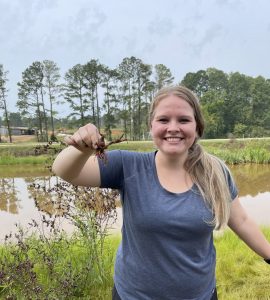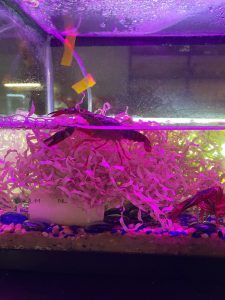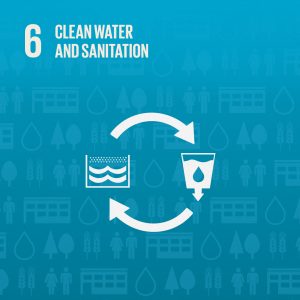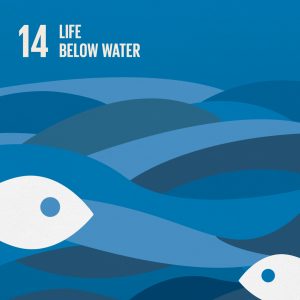By Molly Kilpatrick.
What do crayfish and global water quality have to do with each other?
As it turns out, a lot.
In 2015, 193 countries adopted the 2030 Agenda for Sustainable Development. This agenda provides a framework for peace and prosperity for people and the planet, from now and into the future. The plan includes 17 Sustainable Development Goals (SDG), one of which is to ensure availability and sustainable management of water and sanitation for all. SDG #6: Clean Water and Sanitation includes eight targets to achieve in the coming years. Two of these targets aim to improve water quality by decreasing pollution and protecting and restoring water-related ecosystems.
With the vast number of freshwater ecosystems on the earth, how in the world do we begin to improve the water quality of all of these areas?
My answer is to start small – like the size–of–a–crayfish small.
Every fall, students in Dr. David Blersch’s Ecological Engineering class have a project- to design a small, closed ecosystem that will sustain as many crayfish as possible for the longest amount of time. The closed-system part is key – no inputs, no outputs once the tank has been closed. Sounds challenging, right? Controlling the water quality within the tank makes the project even more challenging.
 To start, my team took a trip to the Auburn University E. W. Shell Fisheries Center to collect as many crayfish as we could. Crayfish live in aquatic or wetland environments, so thanks to the assistance and expertise of Dr. Jim Stoeckel, we managed to collect around 30 Red Swamp crayfish (Procambarus clarkii) and only suffered a few minor pinches.
To start, my team took a trip to the Auburn University E. W. Shell Fisheries Center to collect as many crayfish as we could. Crayfish live in aquatic or wetland environments, so thanks to the assistance and expertise of Dr. Jim Stoeckel, we managed to collect around 30 Red Swamp crayfish (Procambarus clarkii) and only suffered a few minor pinches.
After this, it was really time to get to work. My team gathered a 10-gallon aquarium tank, an aquarium water filter, LED lights, rocks, gravel, sand, and PVC piping to put together our crayfish ecosystem. We added a few crayfish to our system and gave them some creative names, like Cindy Crawfish and Olivia Clawdrigo, and then started monitoring the system’s water quality.
We measured various water quality parameters during the project. The temperature, pH, alkalinity, hardness, nitrate, and phosphate of the water were measured twice daily when the tank was sealed. Different factors affected each parameter. Water hardness changed if you had to add more tap water; the pH varied wildly from day to day; the temperature dropped slightly during the night when the lights were off; and alkalinity increased slightly whenever the crayfish molted. But overall, these changes were normal. In natural systems, ecosystems change and fluctuate all the time, especially when human influences on the ecosystems are considered.
One of the most important water quality parameters for many aquatic organisms, including crayfish, is dissolved oxygen. We knew we needed oxygen in the closed system – oxygen that would eventually be used up by the crayfish, so how did we keep oxygen circulating inside the system?
Plants. Lots of aquatic plants.
Eventually, the plants started to not work out that well for the closed system. While they did a great job at keeping the oxygen up, the crayfish also loved to have them as a little snack, and while being sealed in a tank for seven days, the crayfish were very hungry. Can you really blame them?
After the crayfish consumed the plants, they produced waste that then produced ammonia. Subsequently, microorganisms in the tank broke down the ammonia to nitrite. Crayfish cannot live in an ecosystem containing more than 0.6 parts per million nitrites and 0.06 parts per million ammonias, and our ecosystem came painfully close to reaching these limits.
Nitrite and ammonia were two of the most challenging water quality parameters to control in the ecosystem. So how did we control these parameters and improve overall water quality?
Again, plants.
 Some species of plants can take up ammonia or nitrite as nutrients so adding plants to our tank would have decreased the ammonia and nitrite levels. But we had quickly learned aquatic plants in our closed tank ecosystem would become crayfish midnight snacks. In ecosystems without sealed-off boundaries where other sources of food are available, and plants are more abundant, aquatic plants can stabilize dissolved oxygen and decrease the ammonia and nitrite levels in those ecosystems. While this didn’t work out for our ecosystem, it is a possible solution for the protection and restoration of aquatic ecosystems today.
Some species of plants can take up ammonia or nitrite as nutrients so adding plants to our tank would have decreased the ammonia and nitrite levels. But we had quickly learned aquatic plants in our closed tank ecosystem would become crayfish midnight snacks. In ecosystems without sealed-off boundaries where other sources of food are available, and plants are more abundant, aquatic plants can stabilize dissolved oxygen and decrease the ammonia and nitrite levels in those ecosystems. While this didn’t work out for our ecosystem, it is a possible solution for the protection and restoration of aquatic ecosystems today.
The project eventually ended, our crayfish survived, and they have since been enjoying a happy retirement in the Ecological Engineering lab where they will be part of the Biosystems Engineering Department’s E-Day display. This project taught me more than I ever thought I would know about water quality and the various factors that affect aquatic ecosystems. While our closed crayfish system was just a ten-gallon aquarium with one species of concern in it, the same principles can apply to larger ecosystems. As aquatic ecosystems become larger and include more species, they also become exponentially more complicated to keep healthy. This becomes even harder with contamination from human-caused pollutants such as agricultural runoff, hazardous waste, untreated wastewater, and many more.
However, daunting it may seem, caring for large scale aquatic ecosystems is far from impossible. Just like with the crayfish project, monitoring the water quality, understanding what makes it change, and getting a little creative to find new solutions to improve the water quality can go a long way in the protection and restoration of our aquatic ecosystems. It doesn’t take being a trained ecology researcher to contribute, either. You can get involved now by:
- Becoming a water monitor with Alabama Water Watch
- Pursuing the Watershed Science & Management minor or classes
- Studying research related to water quality
- Exploring SDG 6: Clean Water and Sanitation at Auburn
- Purchasing body products that have high ratings for the environment
- Using Green Seal or Design-for-the-Environment cleaning supplies
- Requesting labs use Auburn University Green Labs practices
- Supporting Students for Clean Water
Start with the above actions and discover more ways you can improve water quality by decreasing pollution and protecting and restoring water-related ecosystems. Starting with something as small as a crayfish can have a big impact on water quality in the world’s ecosystems.
Post contributed by Molly Kilpatrick, Outreach Coordinator, Office of Sustainability
Learn about the SDGs & AU and Auburn’s contributions related to this post:






